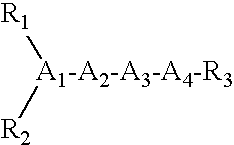Treatment of dry eye
a technology for dry eye and peptides, applied in the field of compositions, can solve the problems of foreign body sensation, sandy-gritty eye feeling, corresponding rise in tear osmolarity,
- Summary
- Abstract
- Description
- Claims
- Application Information
AI Technical Summary
Benefits of technology
Problems solved by technology
Method used
Image
Examples
example 1
LIGR Induces the Expression of Mucin 1 (MUC1) in Corneal Epithelial Equivalents
[0071]Human corneal equivalents were purchased from SkinEthic Laboratories (Nice, France). Equivalents were allowed to equilibrate in SkinEthic growth medium overnight at 5% CO2, and were then treated with SLIGRL (SEQ.ID.NO.17) (200 μM), LIGR (SEQ.ID.NO.1) (200 μM) or Phosphate buffered saline (PBS) as a control. Treatment was refreshed everyday. At the end of the 6th day, equivalent samples were harvested. Total RNA was extracted from the equivalents using RNAqueous™ kit (Ambion, Austin, Tex.) according to manufacture's instructions. RNA samples were then treated with DNA-free kit (Ambion, Austin Tex.). 25 nanograms of total RNA from each sample were amplified using OneStep RT-PCR kit (Qiagen, Valencia, Calif.) according to the manufacture's instructions. PCR Primers were synthesized by Integrated DNA Technologies (Coralville, Iowa). Primer sequences are listed in table 1. Each RT-PCR reaction contained ...
example 2
SLIGRL But Not LIGR Induces Inflammatory Mediators
[0074]Human primary neonatal keratinocytes were purchased from Cascade Biologics (Portland, Oreg.). Cells were cultured in Media 154 supplemented with human keratinocytes growth supplement (Cascade Biologics) and were maintained at 4 per well in 24 well plate and allowed to attach to the well overnight with 5% CO2. Cells were then treated with LIGR (50 μM), SLIGRL (50 μM), the control, scrambled peptide ISLLRG (SEQ.ID.NO.18) (50 μM) or left untreated. Each treatment was done in triplicates. 24 hours later, cell media were collected and examined for the expression and secretion of the inflammatory mediators PGE2, PGF2α, IL-8 and IL-6. PGE2 and PGF2α, using ELISA kits (Cayman Chemicals, Ann Arbor, Mich.) according to manufacturer's instructions. IL-8 and IL-6 levels were detected using Beadlyte Human Multi-cytokine Detection System (Upstate Cell Signaling Solutions, Lake Placid, N.Y.) according to manufacturer's instructions. The exper...
example 3
SLIGRL But Not LIGR Induces Intracellular Ca2+ Influx
[0079]HaCaT cells were seeded in a black-wall 96-well plate at about 20,000 cells / 100 μl / well and grown overnight in culture medium prior to the experiment. On the day of the experiment, cells were loaded with 100 μl of Calcium Plus assay reagent component A (FLEXstation calcium Plus Assay Kit, Molecular Devices, Sunnyvale, Calif.) prepared in Hanks' Balanced Salt Solution (HBSS, Mediatech, Inc., Herndon, Va.) for 30 minutes according to the manufacturer's protocol. After loading the cells, SLIGRL, LIGR and ISSLRG (at 5× concentration in 50 μl) were added to all wells (final volume 250 μl / well), and intracellular Ca2+ levels were subsequently assayed using the FLIPR system (Molecular Devices, Sunnyvale, Calif.) to simultaneously monitor fluorescence in all wells (Wavelength−excitation=488 nm, Wavelength−emission=510 nm) according to the manufacture's protocol. The fluorescence intensity was captured every 3 seconds for the first 3...
PUM
| Property | Measurement | Unit |
|---|---|---|
| osmolarity | aaaaa | aaaaa |
| optically active | aaaaa | aaaaa |
| time | aaaaa | aaaaa |
Abstract
Description
Claims
Application Information
 Login to View More
Login to View More - R&D
- Intellectual Property
- Life Sciences
- Materials
- Tech Scout
- Unparalleled Data Quality
- Higher Quality Content
- 60% Fewer Hallucinations
Browse by: Latest US Patents, China's latest patents, Technical Efficacy Thesaurus, Application Domain, Technology Topic, Popular Technical Reports.
© 2025 PatSnap. All rights reserved.Legal|Privacy policy|Modern Slavery Act Transparency Statement|Sitemap|About US| Contact US: help@patsnap.com

